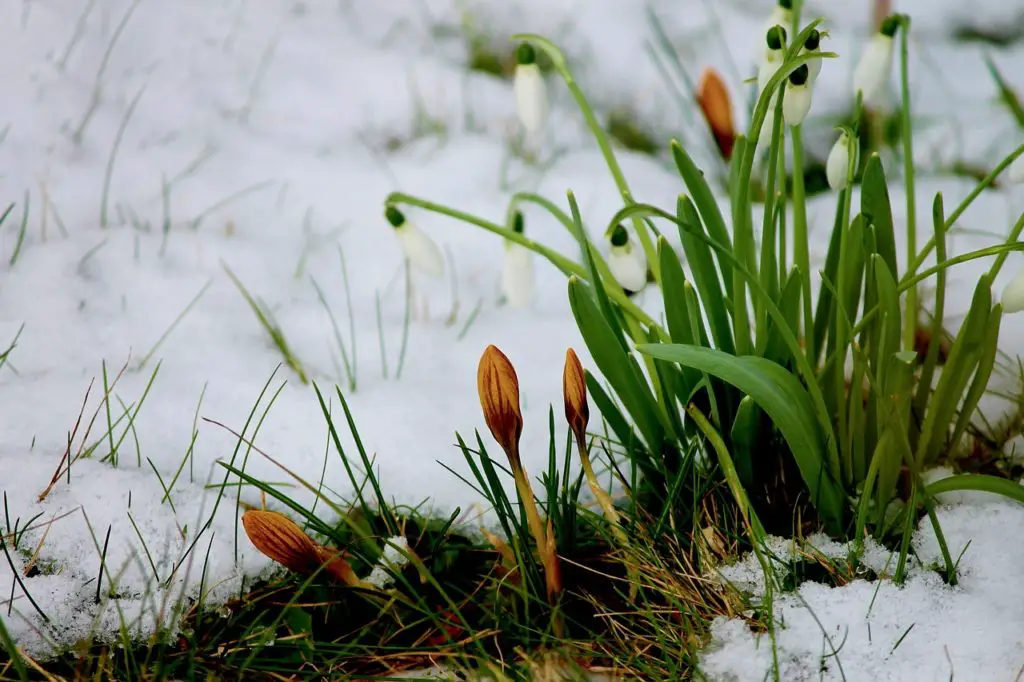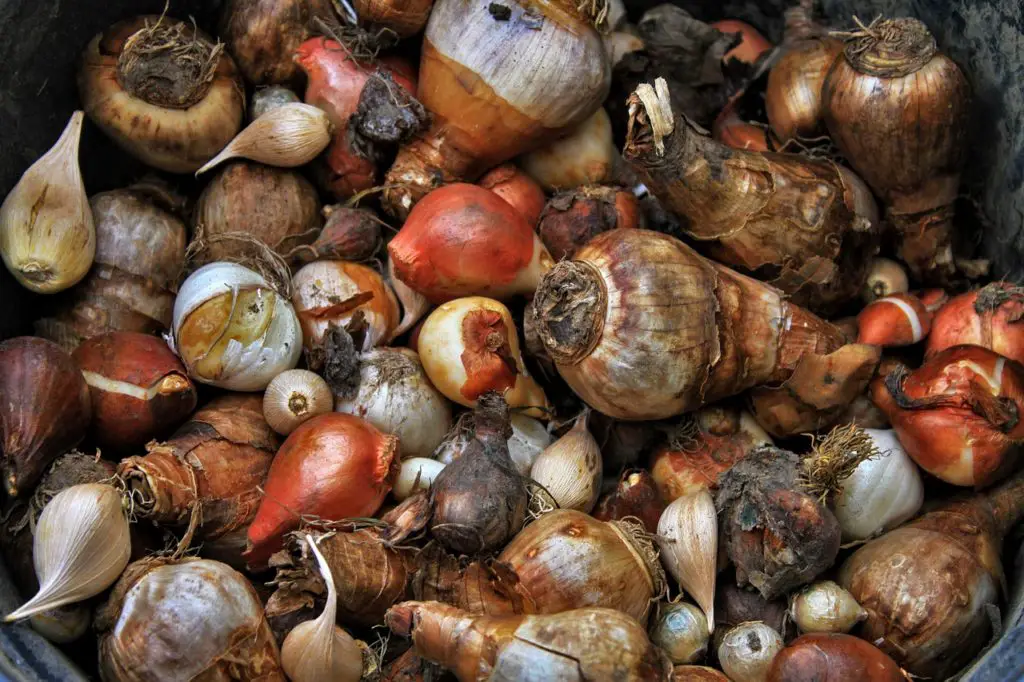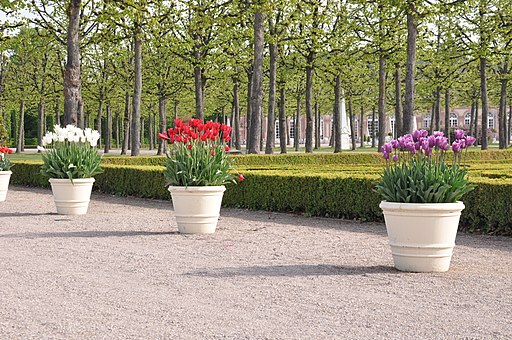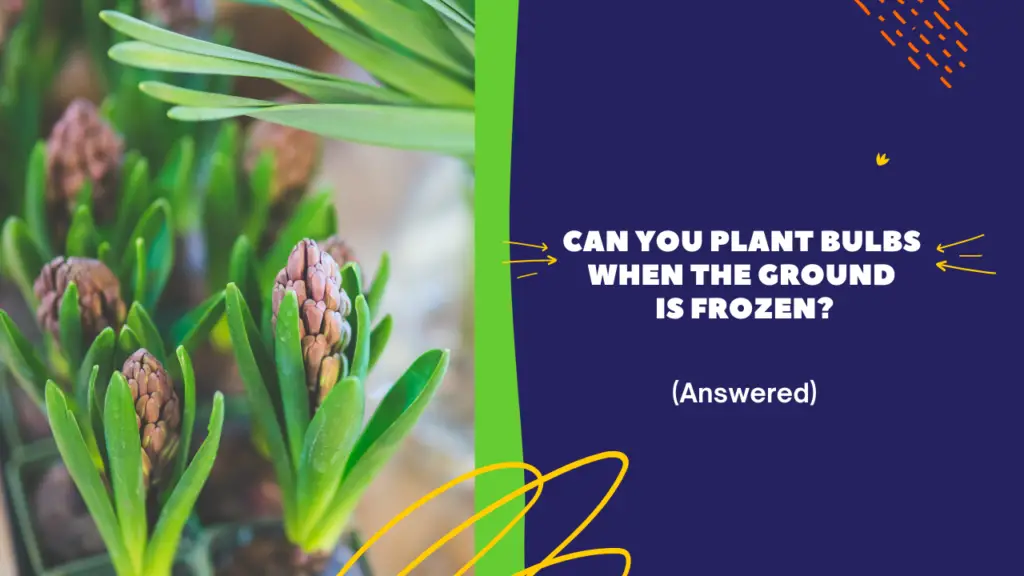The best time to plant many spring flowering bulbs is in the fall but what happens if you miss that deadline and live in one of the colder zones? Can you plant bulbs when the ground is frozen? The Grow Monster will buy bulbs and put them in the garage to plant and promptly forget that the bulbs are ready to go in the ground until we’ve received that first snow or first hard frost. Do you do that too? Here’s some ways you can still plant bulbs when the ground is frozen.
You should plant bulbs when the ground is still workable; but you can plant bulbs when the ground is frozen by digging through the top layer of dirt. Alternatively, you can place the bulbs on the ground with new soil and mulch over them.
Read on to learn how to plant bulbs when the ground is frozen and some tips to protect your bulbs all winter long so you will have beautiful flowers once the spring weather has arrived!

Plant Bulbs When the Ground is Frozen
While you may have already experienced your first freeze, the ground may still be workable. But what is the ground is frozen, can you still plant bulbs when the ground is frozen? You can plant bulbs when the ground is frozen if you are able to dig deep enough for the size of bulb you are planting. Keep in mind, some bulbs like Calla Lily need to be planted after all threat of frost is gone. But, for the winter hardy bulbs like Tulips and Allium, you can still plant well in to the winter after the first frost.
The very top surface of the soil may be all that is frozen. In that case, it will be easy to chip away a bit at the frozen topsoil to remove enough soil to plant your bulbs at the correct depth. If you use mulch in your garden it will be even easier to get to the softer, more workable soil. You may need to use a smaller tine garden rake to pull the mulch off the area that you will want to plant your bulbs. Once the mulch has been removed, you can continue planting your bulbs to the correct depth.
Once your bulbs have been planted, it is important to make sure that the soil is moist but not soggy. Bulbs are susceptible to root rot and do not like standing water. This is not the time to add any fertilizer or non-composted manure to your soil because it can actually burn the bulbs and prevent them from developing strong roots, according to this study. At this point, the roots just need to be able to develop so that the plant will be strong enough for blooming in the spring.
Once you have watered in your bulbs and covered them with soil you can put the mulch back that was already there or add mulch if you previously had none. It is a good idea to mulch your garden to help maintain moisture and prevent weeds. Some people like to mark their bulbs with regular plant marker or even make their own decorative markers to remember what is what for the spring. This would be a great time to mark your plants while you still remember what is planted where!
Plant Bulbs When the Ground is Frozen Solid
If you have been trying to dig in to the ground and find that it is frozen solid, you may be able to get through with a sharp shovel or even a pick axe. But, some locations will have ground that is just not workable no matter how hard you try to dig. Can you still plant bulbs when the ground is frozen solid? You can still plant bulbs when the ground is frozen solid if you plant on top of the ground rather than trying to dig down in to the soil.
If the ground is frozen solid and can’t be easily dug, you can still plant your bulbs outside. Find the area you want to plant the bulbs and remove any snow and mulch (as long as the mulch is not also frozen solid, if it is don’t worry you can still do this method). Put down about an inch or so of new soil over the area. This new soil will be warmer than the ground and a create a great base for setting the bulbs.

Place all your bulbs in the location you want. Remember to place the flat part down and any sprouting area or pointy part facing up and gently press the bulb in to the soil that you already put down over the frozen ground. After your bulbs are in place, you can add more soil until they are at the correct depth for each type of flower.
If you are planting flowers that need to be deeper with flowers that are planted more shallow then just adjust the amount of soil you place below them. For example, you may place larger Tulip bulbs directly on top of the inch of soil whereas you may place a bit more soil where you want to plant smaller Crocus plants. After all your bulbs have been planted, cover them with soil and add mulch. There will be a visible mound, but you can always work this in to your garden aesthetic or replant in the spring.
What if the Ground is Too Frozen to Plant Bulbs?
It may be deep in the middle of winter, snow several inches on the ground, and the soil is hard as ice. What if the ground is too frozen to plant bulbs? If you have tried digging through the frozen soil and are not able to dig down deep enough you can plant bulbs in pots until spring. The pots will need to be kept away from the elements unless they are large enough and insulated against the winter weather.
If the ground is too frozen to dig and planting the bulbs on top of the soil in a mound is just not feasible then you will want to plant your bulbs in pots. Your bulbs will be able to develop the proper root systems and will bloom in spring. You can then allow the flowers to bloom in the pots or risk transplanting when the ground is workable (caution: if you do transplant you may stunt the plant or not get any blooms at all).
When planting bulbs in pots, the most important things to remember are the planting depth, putting them in a well-draining container, and monitoring the temperature of the container. If you keep these three things in mind you can safely plant the bulbs in containers even though the weather outside is not conducive to planting the bulbs in the ground. The pots may be left outside or inside in a garage, well-ventilated basement, or even in your living room if you would like your bulbs to bloom earlier.

When placing the bulbs in the pots, remember the required planting depth for each type of bulbs. This planting depth will differ between plants depending on the size of the bulbs. You can place about an inch of soil in the bottom of the pot (make sure there are adequate drainage holes) and then place the largest bulbs on the bottom and add more soil as you work your way up to the smaller bulbs. This way you will have staggered blooming and also a variety of plants if your pot is large enough. Make sure your bulbs are also adequately spaced depending on variety.
Once you have added all your bulbs to the pots, cover with a layer of mulch to help keep the moisture in the soil because pots tend to dry out more easily. You could also add some sort of cloche to the top if you are worried about the pot drying out or getting too cold outside. This will create a mini greenhouse of sorts, but it may end up forcing your bulb to bloom earlier if the temperature inside the cloche is warmer than it normally would be in your growing zone.
Once you have your pots planted you can huddle them together outside and bury them in a new layer of soil or mulch or you can bring them inside for the rest of the season. Remember to place the pots in a well-ventilated area and not to let the soil get too soggy otherwise your bulbs may be susceptible to root rot. Once you start noticing your bulbs begin to send up leaves you can move them to a sunnier part of the home and watch them bloom. Flowers that are kept inside tend to bloom earlier than those that are planted outside. Otherwise, you can take the pots outside to bloom alongside those that were previously planted outside.

Final Thoughts
Even if it is the middle of winter you can still plant bulbs. Many times we just forget we bought them or something else gets in the way and we end up wanting to plant the bulbs once it is snowing and the ground is frozen. Luckily, you can still plant bulbs when the ground is frozen. And, if you really are too late or the ground just isn’t able to be worked you can always fall back on putting your bulbs in pots to enjoy the beauty of your flowers in the spring.


Pingback: The Definitive Guide to Winter Sowing - 9 Easy Steps with Photos - The Grow Monster